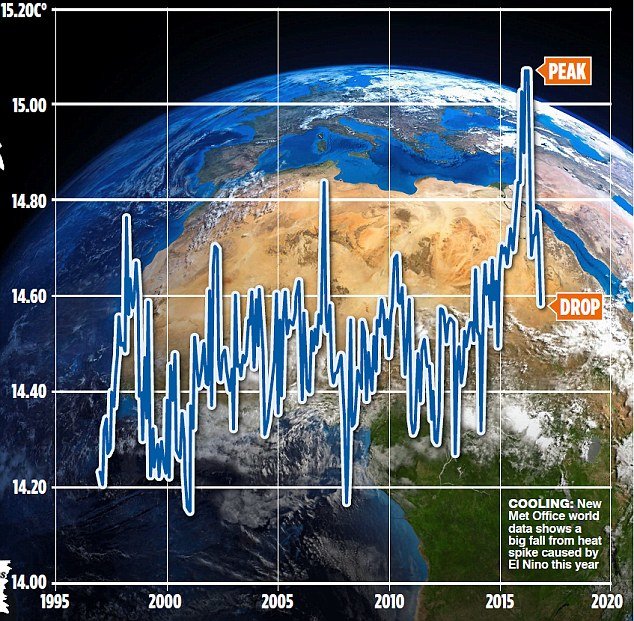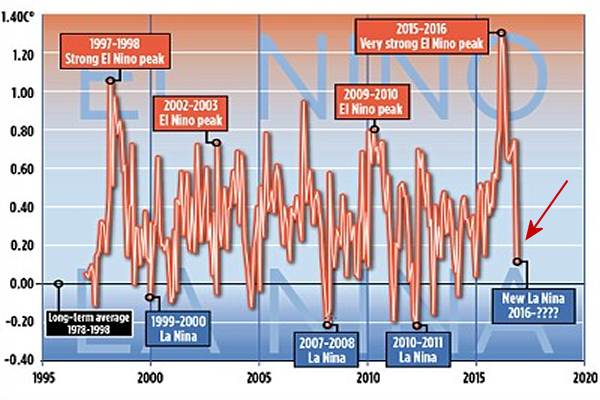
The huge fall follows a report by this newspaper that temperatures had cooled after a record spike. Our story showed that these record high temperatures were triggered by naturally occurring but freak conditions caused by El Nino - and not, as had been previously suggested, by the cumulative effects of man-made global warming.
The Mail on Sunday's report was picked up around the world and widely attacked by green propagandists as being 'cherry-picked' and based on 'misinformation'. The report was, in fact, based on NASA satellite measurements of temperatures in the lower atmosphere over land - which tend to show worldwide changes first, because the sea retains heat for longer.
It is true that the massive 2015-16 El Nino - probably the strongest ever seen - took place against a steady warming trend, most of which scientists believe has been caused by human CO2 emissions
However, now the drop in temperature is also showing up in the authoritative Met Office 'Hadcrut4' surface record, compiled from measurements from more than 3,000 weather stations located around the world on both sea and land.
To the end of October, the last month for which figures have been released, Hadcrut4 had fallen about 0.5C from its peak in the spring.
The reason is the end of El Nino. The natural phenomenon, which takes place every few years and has a huge impact on world weather, occurs when water in a vast area of the Pacific west of Central America gets up to 3C hotter than usual.
It has now been replaced by a weak La Nina, when the water becomes colder than usual. This means temperatures may still have some way to fall.
El Nino is not caused by greenhouse gases and has nothing to do with climate change. It is true that the massive 2015-16 El Nino - probably the strongest ever seen - took place against a steady warming trend, most of which scientists believe has been caused by human emissions.
But when El Nino was triggering new records earlier this year, some downplayed its effects. For example, the Met Office said it contributed 'only a few hundredths of a degree' to the record heat. The size of the current fall suggests that this minimised its impact. When February produced a new hot record for that month, at the very peak of El Nino, newspapers in several countries claimed that this amounted to a 'global climate emergency', and showed the world was 'hurtling' towards the point when global warming would become truly dangerous. Now, apparently, the immediate threat has passed. It would be just as misleading to say lower temperatures caused by La Nina meant the world was into a new long-term cooling.
The Mail on Sunday's report was picked up around the world and widely attacked by green propagandists as being 'cherry-picked' and based on 'misinformation'
But the big question is: what will happen when both El Nino and La Nina are over and the Pacific water returns to its 'neutral', average state?
Professor Judith Curry, of Georgia Tech in Atlanta, who is president of the Climate Forecast Applications Network, said it would take years before it was clear whether the long-term warming trend was slowing down, staying the same or accelerating.
'The bottom line is that we can't read too much into the temperatures of a year or two,' she said. 'We will need the perspective of another five years to understand what is going on.'
Full story by David Rose in Mail on Sunday, 11 December 2016




teeter-totter effect as the deviations expand like a top getting ready to fall down and stop.